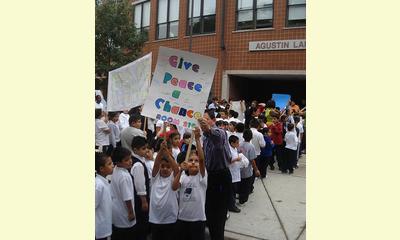|
|
Peace Promotion Can Work (Chicago)
un articulo por Barry Weisberg (abridged)
All of the measures now proposed in the US to “stop” the gun violence are insufficient: gun laws, more police, surveillance, greater social control in black communities, mentoring, more jobs, better parenting, or after school programs. Some may help prevent future violence, but they will not reverse the pattern of domestic gun violence. They are partial, inadequate responses to systemic failures.

photo from Chicago Build the Peace Committee
click on photo to enlarge
Gun violence is not a mere “epidemic” that can be “interrupted.” A street “ceasefire” does not remove the fire power. Guns are one thread of a fabric of economic, social, political and cultural factors that are central to the Culture of Violence in the US. . .
In Chicago, at least three initiatives are essential.
First, the Mayor must reconsider his ill conceived and outdated corporatists crime control and Violence Containment policies and instead link growth to community development and human well-being initiatives. His administration, as did Mayor Daley and Maggie Daley before him, must join the community based build the peace efforts in Chicago. The budgets of neighborhoods, communities and cities must reject the ill-conceived Violence Containment strategies that are so counter-productive. The alternative is to mainstream a culture of peace that insures individual, family and community well-being. This kind of leadership is essential in all cities with extreme violence.
Second, what are needed in the most violent communities are Community Development and Investment Banks (CDIB). But it would be unlike either the World Bank International Bank for Reconstruction and Development or the US$50 million Public Safety Action Committee Mayor Emanuel and the First Lady Obama are funding in Chicago. By contrast, Millennium Park in Chicago cost $457 million! However, the primary goal should not be downtown “safety” but human development and well being. Community well being indicators must be insured for the most violent neighborhoods. A CDIB, controlled by communities and local business, not municipal government or “global city” corporations, would work with every family, school, and neighborhood in select communities suffering from extreme violence and dispossession. This is a complex social, economic, political and cultural challenge, not merely an individual choice.
Whole neighborhoods and communities must be transformed, breaking the inter-generational transmission of violence. This is not accomplished by only creating more choices for some individuals. It includes working with every individual, family, school, health care provider and other basic institutions in a violent community.
Third, is peace education. The Chicago Public Schools should promote a K-12 Build the Peace Curriculum. In the words of Maria Montessori, “to reach peace we must teach peace.” It is not enough to reduce and prevent the violence; we must promote the values, attitudes and behaviors of peace. The content and form would be integrated into the existing physical, natural and social sciences, the humanities, and applied to everyday family, school and community activity. This should be linked to the pioneering thirty five year old Chicago Build the Peace Committee, in conjunction with the United Nations Annual Day of Peace, June 21st.
Gun control could only be effective within the context of human well-being, community development, violence prevention and peace building. Gun violence is only one poisonous fruit from a poisonous tree.
|








|
DISCUSSION
Pregunta(s) relacionada(s) al artículo :
How important is community development for a culture of peace?,
* * * * *
Comentario más reciente:
:
Community plays a important role in developing culture peace. We should promote our cultural values by interacting with each other and making these values part of our daily lives. A good example of this would be raising our children according to beliefs and values which are important for us and our cultural peace. We can also promote cultural peace by making small commuinties within big community and share different ideas and bring new ones in.

|
|









